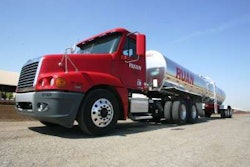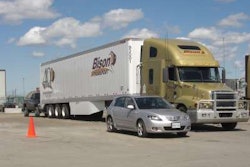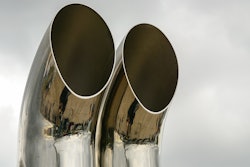For radiators, paying attention to basics pays dividends
Most fleet managers probably know that initial exhaust gas recirculation designs produced a drastic increase in engine heat rejection, and that 2007 brought a further significant increase. Re-breathing warm exhaust increases engine compression temperature, which means significantly more heat passing through the pistons, liners and cylinder head, and into the coolant and oil.
As if that were not enough, EGR also requires the cooling system to bring a significant percentage of the exhaust down from temperatures more than 1,000 degrees Fahrenheit to less than 250 degrees Fahrenheit via the EGR cooler – and then shed all that heat.
Truck makers were faced with the need to get rid of all that energy while retaining aerodynamic designs that already had squeezed the radiator into a small space. The radiator needed to shed much more heat without a much larger cross-section, and increasing fan horsepower draw was not acceptable.
As usual, the industry confronted the problem with creative solutions that ended up working well. Daimler Trucks’ Benjamin Smith, manager of product strategy, brags that fan on-time is less and fan power draw is lower. Kenworth’s Preston Feight, chief engineer, says cooling capacity has increased while weight has decreased.
Mounting fan shrouds on the engine made tight blade-to-shroud clearances practical, thus reducing warm air recirculation and increasing the amount of air moved with the same fan horsepower. Newly designed blade configurations helped efficiency while keeping noise under control. In some designs, pressure caps with higher ratings made higher coolant temperatures practical, helping radiators shed heat more easily. Thinner tubes and fins placed more closely increased heat transfer while minimizing the needed radiator size.
Maintenance matters
However, all of this places more stress on the system, and thus on the maintenance department. Especially important is cleaning the fins with a wand designed for this purpose. A partially clogged charge air cooler mounted in front not only will slow airflow through the radiator, but also will increase the amount of heat the coolant needs to remove from the engine. Two-piece fan shrouds – introduced by both International and Daimler Trucks – make them easier to remove for cleaning.
Daimler Trucks allows both ELC and traditional coolants with SCAs, Smith says. Kenworth prefers ELC, according to Feight. Landon Sproull, Peterbilt’s chief engineer, says the company puts ELC into new trucks as the standard coolant, but recommends the use of any coolant approved by the engine OEM. Navistar uses ELC in its evaluations and may void the warranty if anything other than ELC is used in the field, says George Banta, Navistar’s chief engineer of cooling powertrain systems. Caterpillar prefers ELC, says Neil Terry, aftertreatment and cooling products supervisor.
What is clear, according to experts, is that the two different types of coolant must not be mixed. “Substituting a coolant composition other than the factory-recommended coolant or mixing different coolant technologies does occur in the field, but the protection provided by the ELC is lost,” Banta says. Once conventional coolant content passes 10 percent, the system must be maintained with SCAs, and the coolant will have to be changed sooner.
Designing these systems may have been rocket science, but apparently maintenance is not. Smith says that in addition to standard routine maintenance, shops should pay attention to removal of debris from the radiator and charge air cooler to help ensure premium performance. Navistar recommends following the maintenance intervals highlighted in its service manuals. “Maintaining the coolant level is important, but coolant condition and chemistry is critical,” Banta says.
When Caterpillar sees cooling system problems, they usually are related to maintenance in some manner, Terry says. “Keeping the system topped off, changing coolant and temperature regulators at proper intervals, and checking for system leaks and testing pressure caps all come to mind,” he says. Drivers should fill the surge bottle to just below the full mark if the truck uses this method of keeping the radiator full.
Drivers should check coolant level during their daily walkaround and note leaks for the shop to fix. Fleets should develop a regular schedule for replacing thermostats rather than waiting for them to fail, and also periodically should pressure-check the entire system, including the cap, which may leak due to trapped debris. Leaks mean loss of the pressure needed to ensure that all engine components are protected properly by liquid coolant, as opposed to the boiling variety.
Kenworth’s fleet customers typically do a good job of maintaining their cooling systems, Feight says. “Performing simple daily checks of the cooling system components – including fan drive, belts, coolant level and component cleanliness – offers the best defense in identifying issues before they result in downtime,” he says.
Sproull says the most important element of cooling system maintenance is inspection. “A simple look at the radiator during your pre-trip inspection will reveal any obvious defects,” he says. “This simple act will reveal any potential plugging from bugs or road debris. This daily inspection will alert the operator of any road damage that may have occurred.” A small cooling system leak caused by a rock punch will show up as a wet spot, and if left untreated could lead to a complete system failure.
The second most important element in care of the cooling system is coolant maintenance and inspection, Sproull says. “The coolant should be considered the lifeblood of the truck,” he says.
Fleets also should replace recirculation shields that are damaged, Sproull says; these devices prevent heated air from mixing with the fresh cool air passing through the heat exchangers, which would degrade performance. Also critical is replacing heat shields that protect hoses and other parts from engine exhaust heat. And when replacing hoses, use constant tension clamps, not conventional clamps, to ensure a continued seal.
As usual, it all comes down to a number of simple details that should be checked on a regular schedule.











